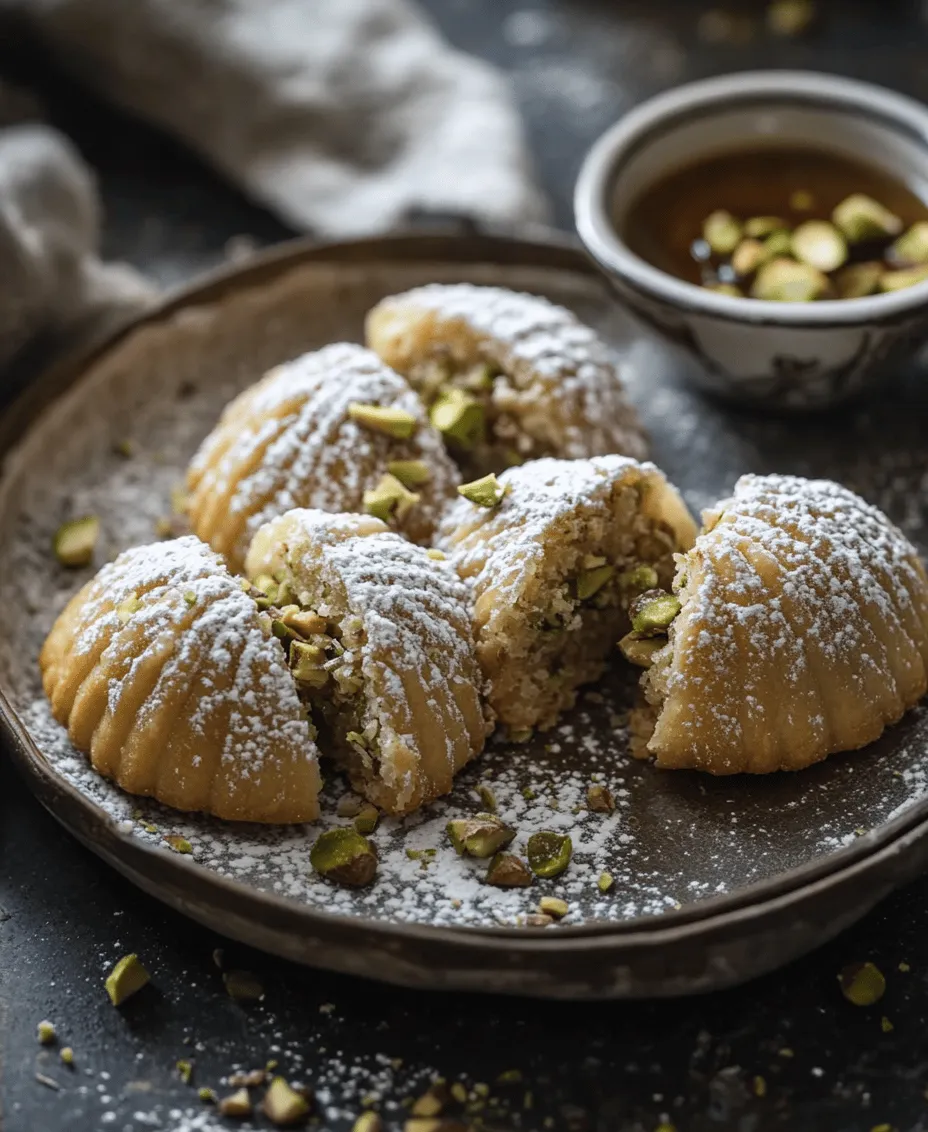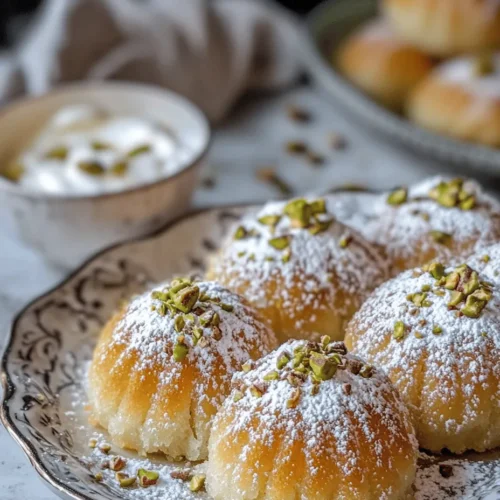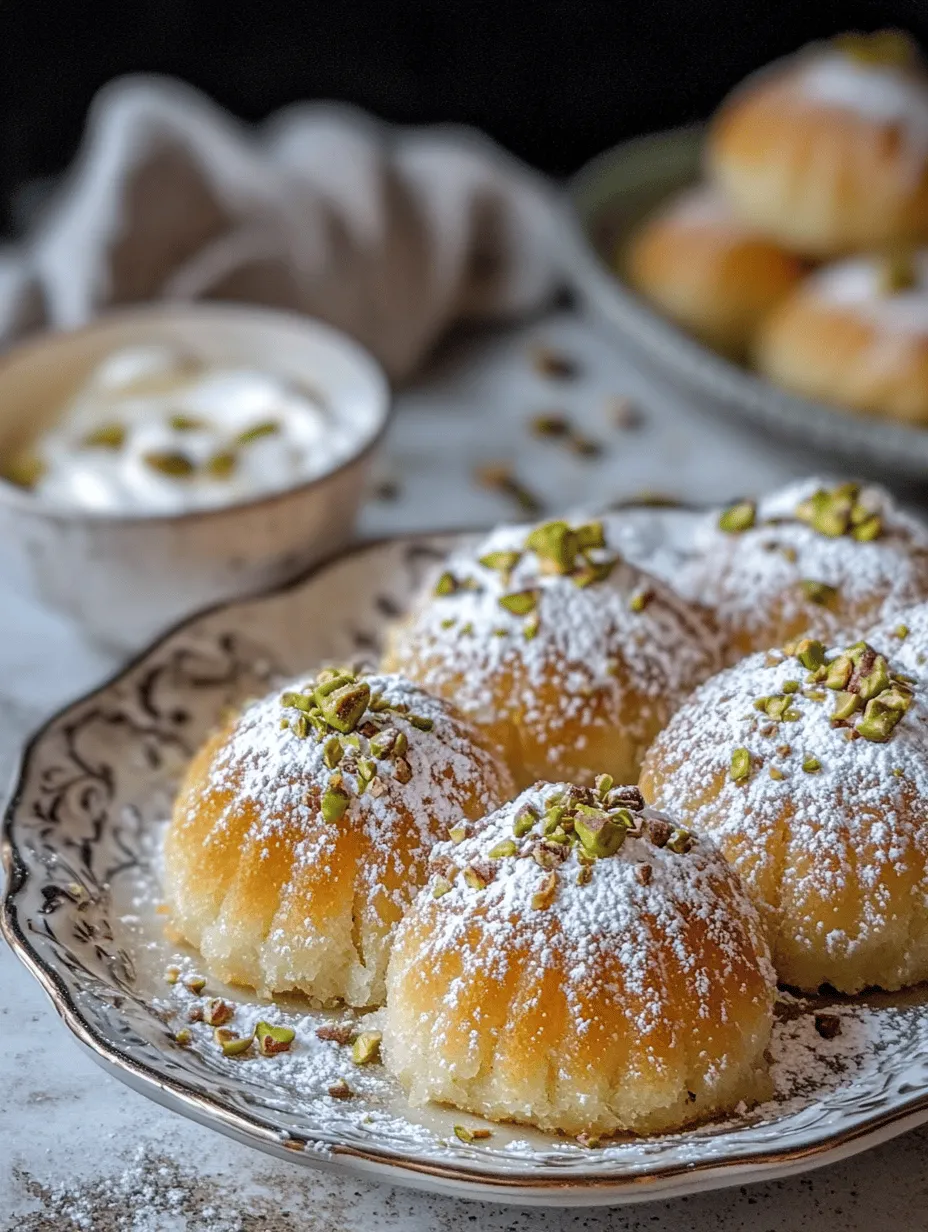Introduction
Maamoul, a traditional Middle Eastern pastry, holds a cherished place in the hearts and homes of many across the region. These delightful cookies, often filled with dates, nuts, or cream, are more than just a treat; they are a symbol of hospitality and celebration. Maamoul is usually prepared during festive occasions, such as Eid and Christmas, and is often enjoyed alongside family gatherings, making it a staple in Middle Eastern cuisine. Its cultural significance transcends mere flavor, embodying the warmth of shared moments and cherished traditions.
This particular recipe focuses on a unique twist: Maamoul Mad Pistachio with Ashta. The combination of ground pistachios and the rich, creamy Ashta (a type of clotted cream) creates a luxurious dessert that is both indulgent and satisfying. The nutty flavor of the pistachios pairs perfectly with the smooth, sweet Ashta, making each bite a delightful experience. There’s something special about creating these treats at home, as they not only offer a taste of tradition but also provide a sense of accomplishment when crafted from scratch.
Understanding Maamoul
Definition and Origin of Maamoul
Maamoul is a type of shortbread cookie originating from the Levant region, particularly popular in countries such as Lebanon, Syria, and Palestine. The word “maamoul” is derived from the Arabic verb “a’mala,” meaning “to make.” Traditionally, these cookies are made during special occasions, and their fillings vary widely, ranging from nuts like walnuts and pistachios to sweetened dates.
The history of Maamoul dates back to ancient times, with some sources suggesting that the pastry may have originated in the early Arab world. Over centuries, it has evolved into various regional forms, with each culture adding its own twist. In some areas, the dough is flavored with spices or enhanced with different types of nuts, while others prefer a more straightforward approach, focusing purely on the quality of the ingredients. The traditional method of preparing Maamoul involves intricate shaping and filling, often using wooden molds that imprint beautiful designs on the cookies.
Traditional Methods of Preparation and Serving
Preparing Maamoul is a labor of love, often involving family members coming together to create these festive treats. The dough is typically made with a mix of all-purpose flour and semolina, giving it a unique texture that is both crumbly and soft. Once the dough is made, it’s rolled into small balls, filled with the chosen filling, and then shaped using molds or by hand.
Maamoul is usually served dusted with powdered sugar, adding a touch of sweetness and visual appeal. These cookies can be enjoyed with a cup of Arabic coffee or tea, enhancing their flavor profile and making for a delightful afternoon snack. The process of making Maamoul is as much about the experience as it is about the final product, with families often passing down their recipes and techniques through generations.
Significance of Pistachios in Middle Eastern Sweets
Pistachios are a beloved ingredient in many Middle Eastern desserts, known for their vibrant green color and distinctive flavor. Rich in nutrients, pistachios offer a range of health benefits, including high protein content, healthy fats, and antioxidants. Their natural sweetness and buttery texture make them an ideal filling for pastries and desserts, complementing the richness of creams and chocolates.
In the context of Maamoul, pistachios not only enhance the taste but also provide a pleasing crunch that contrasts beautifully with the smoothness of the Ashta. The use of pistachios in this recipe not only elevates the flavor but also pays homage to the traditional practices of using premium ingredients in Middle Eastern sweets.
Ingredients Overview
Creating the perfect Maamoul Mad Pistachio with Ashta involves a careful selection of ingredients, each playing a crucial role in achieving the desired flavor and texture. Below is a detailed explanation of each key ingredient, highlighting their significance in the recipe.
Key Ingredients for Maamoul
1. All-Purpose Flour and Semolina: These two ingredients are foundational to the dough. All-purpose flour provides the bulk of the structure, while semolina adds a unique texture that makes the cookies crumbly yet tender. The combination results in a delightful bite that melts in your mouth.
2. Unsalted Butter: Butter is essential for flavor and moisture. Using unsalted butter allows you to control the salt content of your dough, ensuring a well-balanced taste. The fat in the butter contributes to the richness of the cookies, making them incredibly satisfying.
3. Powdered Sugar: This ingredient not only sweetens the dough but also contributes to its texture. The fine granules of powdered sugar dissolve easily, creating a smooth mixture that helps achieve the delicate crumb structure of the Maamoul.
4. Ground Cinnamon and Salt: Ground cinnamon enhances the flavor profile of the cookies, adding warmth and depth. A pinch of salt balances the sweetness, ensuring that the cookies are not overly sugary while enhancing the overall flavor.
5. Warm Milk and Vanilla Extract: Warm milk serves as a binding agent, helping to bring the dough together. Vanilla extract adds an aromatic flavor that complements the sweetness of the powdered sugar and the nuttiness of the pistachios.
6. Pistachios: Ground pistachios are the star of this recipe. They impart a rich, nutty flavor and a vibrant green color to the filling. In addition to their delicious taste, pistachios are packed with nutrients, making them a wholesome choice for dessert.
Breakdown of Ashta Cream Components
1. Whole Milk and Heavy Cream: These two dairy products create a rich, creamy base for the Ashta. The combination of whole milk and heavy cream provides the desired consistency and luxurious mouthfeel, making the Ashta a decadent addition to the Maamoul.
2. Cornstarch: Cornstarch acts as a thickening agent, helping to achieve the perfect creamy texture for the Ashta. It ensures that the cream holds its shape when piped into the cookies, preventing any leakage.
3. Sugar and Vanilla Extract: Sugar sweetens the Ashta, while vanilla extract enhances its flavor. Together, they create a delightful cream that complements the nutty filling of the Maamoul.
4. Rose Water (optional): While not a necessary ingredient, rose water adds a subtle floral note that is characteristic of many Middle Eastern desserts. It can elevate the Ashta’s flavor, making it even more aromatic and inviting.
Preparation Steps
Step-by-Step Guide on Preparing the Dough
1. Mixing Dry Ingredients: Begin by sifting together the all-purpose flour, semolina, powdered sugar, ground cinnamon, and salt in a large mixing bowl. This ensures that the ingredients are well-combined and helps to aerate the flour mixture, resulting in a lighter dough.
2. Incorporating Butter: Cut the unsalted butter into small cubes and add it to the dry ingredients. Using your fingers or a pastry cutter, work the butter into the flour mixture until it resembles coarse crumbs. This step is crucial, as the butter needs to be evenly distributed to create a tender texture.
3. Kneading the Dough: Gradually add the warm milk and vanilla extract to the mixture, mixing gently until a dough forms. Turn the dough out onto a lightly floured surface and knead it for a few minutes until it becomes smooth and pliable. The kneading process is vital for developing gluten, which gives the dough structure.
4. Achieving the Right Consistency: The dough should be soft but not sticky. If it feels too dry, add a little more warm milk, a teaspoon at a time. Conversely, if it’s too sticky, sprinkle a small amount of flour as needed. The goal is to achieve a dough that holds together well without being overly dry.
Instructions for Shaping Maamoul
1. Dividing the Dough: Once the dough has reached the desired consistency, divide it into small balls, roughly the size of a walnut. This size makes for a manageable portion, allowing for even baking.
2. Filling and Sealing the Dough: Take each ball of dough and flatten it in the palm of your hand. Place a spoonful of the prepared pistachio filling in the center, followed by a dollop of Ashta cream. Carefully fold the edges of the dough over the filling, sealing it completely. Ensure there are no gaps, as this will prevent the filling from leaking during baking.
3. Using Molds vs. Hand-Shaping: For an authentic touch, you can use traditional wooden molds to shape your Maamoul. Dust the mold with a little flour to prevent sticking, press the filled dough ball into the mold, and gently tap it out onto a baking tray. If you prefer a more rustic look, hand-shaping is also a beautiful option and allows for personal creativity in the design.
These initial steps in preparing the Maamoul Mad Pistachio with Ashta set the foundation for a delightful dessert that embodies the rich traditions of Middle Eastern cuisine. As you continue through the recipe, you’ll find that the care and attention you put into each stage will pay off in the form of delicious, homemade treats that are sure to impress.

Baking Tips for Maamoul Mad Pistachio
When it comes to baking Maamoul Mad Pistachio, a few essential tips can ensure that your cookies turn out perfectly every time. Understanding the baking process is key to achieving the delightful texture and flavor that characterizes this popular Middle Eastern treat.
Optimal Baking Temperature and Time
The ideal temperature for baking Maamoul is typically set at 350°F (175°C). This moderate heat allows the cookies to bake evenly, ensuring they are cooked through without becoming overly brown or dry. Bake the Maamoul for about 15-20 minutes, but keep an eye on them, as baking times can vary based on your oven and the size of your cookies.
Recognizing Visual Cues for Doneness
Visual cues are crucial to determining the perfect doneness of your Maamoul. When the cookies are golden brown on the edges but still slightly paler in the center, they are ready to be taken out of the oven. They will continue to cook slightly from residual heat even after being removed, so avoid over-baking, which can lead to a dry texture.
Cooling Techniques to Maintain Texture
Once your Maamoul are baked, it’s important to cool them properly to maintain their delicate texture. Transfer the cookies to a wire rack to allow air circulation, which helps prevent them from steaming and becoming soggy. Let the cookies cool completely before serving or storing to preserve their crispness.
Making the Ashta Cream
Ashta, the creamy filling that accompanies Maamoul, is a rich and decadent addition that elevates your dessert to new heights. Here’s how to prepare this delightful cream.
Detailed Instructions for Preparing Ashta
To make Ashta, you will need the following ingredients: whole milk, heavy cream, cornstarch, sugar, vanilla extract, and optionally, rose water for added flavor.
1. Simmering Milk and Cream: Start by combining equal parts of whole milk and heavy cream in a saucepan. Heat the mixture over medium heat, stirring occasionally to prevent scorching. You want to bring the mixture to a gentle simmer, not a boil. This process helps to meld the flavors and create a rich base for your Ashta.
2. Creating a Cornstarch Slurry: In a separate bowl, mix about two tablespoons of cornstarch with a few tablespoons of cold water to form a smooth slurry. This step is crucial, as the cornstarch acts as a thickening agent that will give your Ashta its characteristic creamy texture.
3. Thickening the Mixture: Once the milk and cream mixture is simmering, gradually whisk in the cornstarch slurry. Continue to stir constantly as the mixture thickens, which should happen within a couple of minutes.
4. Flavoring with Vanilla and Optional Rose Water: After achieving the desired thickness, remove the saucepan from the heat and stir in the vanilla extract. If you want to add a floral note, consider adding a teaspoon of rose water. The balance of these flavors is essential; adjust according to your preference.
5. Tips for Achieving Perfect Consistency and Flavor Balance: The consistency of your Ashta should be thick but pourable. If it’s too thick, you can whisk in a little more warm milk or cream until you reach the desired texture. Taste the Ashta before serving; if it needs more sweetness, feel free to add a little more sugar.
Assembling the Maamoul
Once your Maamoul and Ashta are prepared, it’s time to assemble and serve this delightful dessert.
Instructions for Serving
1. Drizzling or Serving Ashta Cream on the Side: You can either drizzle the warm Ashta over your Maamoul or serve it in a small bowl on the side for guests to add as they wish. This approach allows everyone to enjoy the cream to their liking.
2. Garnishing Techniques: To elevate the presentation, consider garnishing the Maamoul with a sprinkle of finely chopped pistachios and a dusting of powdered sugar. This not only enhances the visual appeal but also adds an extra layer of flavor and texture.
Pairing Suggestions
Maamoul Mad Pistachio pairs beautifully with various beverages. Traditional Arabic coffee, with its strong and aromatic flavor, complements the sweetness of the cookies perfectly. Alternatively, a cup of fragrant mint tea can also enhance your dessert experience.
Best Practices for Enjoying the Dessert
To fully enjoy the Maamoul, take the time to savor each bite. The combination of flavors from the pistachios, the buttery dough, and the luxurious Ashta creates a memorable experience. Share the cookies among family and friends, as Maamoul is often best enjoyed in good company.
Cultural Context and Celebrations
Maamoul is a cherished treat in many Middle Eastern households, often associated with significant cultural occasions and traditions.
Discussion of Occasions Where Maamoul is Traditionally Served
Maamoul is commonly prepared during religious holidays, such as Eid al-Fitr and Eid al-Adha, symbolizing celebration and hospitality. These festive times see families coming together to bake large batches of Maamoul, sharing them with relatives and neighbors as a gesture of goodwill.
Family gatherings and special celebrations, such as weddings and birthdays, also frequently feature Maamoul as a beloved dessert. The act of sharing these cookies represents not only the joy of the occasion but also the warmth of family ties.
The Role of Maamoul in Middle Eastern Hospitality and Gifting Traditions
In Middle Eastern culture, hospitality is paramount. Offering Maamoul to guests is a way to express generosity and kindness. It is common to present beautifully packaged boxes of Maamoul as gifts during holiday visits or special occasions, further solidifying its role in cultural traditions.
Insights into Unique Family Twists on the Traditional Recipe
Every family may have their unique spin on the Maamoul recipe, be it through the choice of nuts, the type of filling, or the addition of spices like cinnamon or cardamom. These variations reflect personal tastes and regional influences, creating a rich tapestry of flavors and traditions.
Nutritional Information
Understanding the nutritional content of Maamoul Mad Pistachio can help you make informed choices when enjoying this treat.
Breakdown of the Nutritional Content Per Serving
On average, one piece of Maamoul Mad Pistachio contains approximately:
– Calories: 150-200
– Fats: 8-10 grams
– Sugars: 6-8 grams
– Carbohydrates: 20-25 grams
The nutritional profile can vary depending on the specific ingredients used, such as the amount of butter or sugar.
Discussion on Balance and Moderation When Enjoying Sweets
While Maamoul is indulgent, enjoying it in moderation as part of a balanced diet allows you to savor its flavors without feeling guilty. Pairing it with a healthy beverage or enjoying it as part of a festive meal can enhance your overall experience.
Conclusion
Making and enjoying Maamoul Mad Pistachio with Ashta is not just a culinary endeavor; it’s a journey into the heart of Middle Eastern culture and tradition. The rich flavors, delightful textures, and the act of sharing this treat with loved ones create cherished memories.
Preserving culinary traditions like Maamoul is essential in a rapidly changing world. It allows us to connect with our heritage and share the warmth of our culture with others. As you explore and experiment with this recipe, remember that the kitchen is a space for creativity and connection.
We encourage you to dive deeper into the rich world of Middle Eastern cuisine by trying out more recipes. Whether it’s savory dishes or sweet delights, each recipe is an opportunity to celebrate the flavors and stories that unite us. Enjoy your culinary adventure!


